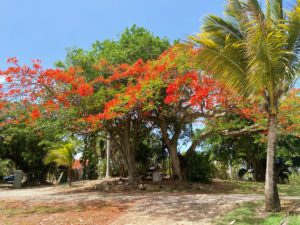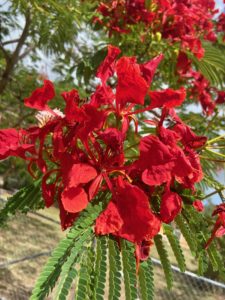If you find yourself in St. Croix during the warm summer months you will more than likely notice the vibrant red and orange colored trees scattered around the island. These striking trees are eye-catching and produce beautiful blooms favorited by many. The Scientific name, Delonix Regia, is probably unfamiliar to most. In fact, the tree has several names, Royal Poinciana, being another one although it’s most well known as the “Flamboyant Tree.” This tropical tree loves the Caribbean climate and can withstand drought and the frequent salty air.
 The bright colored flowers on the tree have four petals of red and orange with a fifth upright petal spotted with yellow, red and white. The Flamboyant tree also has long slender seed pods that can extend out a foot long. On a windy day you can probably hear the seeds rattling above you. Many Crucian children are known to have grown up playing with the pods as musical instruments known as “shack shacks”
The bright colored flowers on the tree have four petals of red and orange with a fifth upright petal spotted with yellow, red and white. The Flamboyant tree also has long slender seed pods that can extend out a foot long. On a windy day you can probably hear the seeds rattling above you. Many Crucian children are known to have grown up playing with the pods as musical instruments known as “shack shacks”
If you live here in St. Croix and want your own Flamboyant you will need to collect some seeds, soak them in warm water for at least 24 hours and plant in warm, moist soil in a semi-shaded area. This method will allow moisture to penetrate the outer casing, and start the germination. The seedlings can grow quickly at a rate of 30 cm in just a few weeks. Keep in mind the conditions must be ideal for this kind of progress.
 The tree is native to Madagascar but commonly grows in the Caribbean, Africa and Northern Australia. They can reach a height of 40 feet and provide great shade for homes and people with its umbrella shaped canopy. It can take up to 10 years to mature and is even the national flower of St. Kitts and Nevis. The name Royal Poinciana was apparently named “Poinciana” by the English on St. Kitts in honor of French Governor, Phillipe de Longviliers de Poincy. Some even claim Poincy introduced the tree to the America’s.
The tree is native to Madagascar but commonly grows in the Caribbean, Africa and Northern Australia. They can reach a height of 40 feet and provide great shade for homes and people with its umbrella shaped canopy. It can take up to 10 years to mature and is even the national flower of St. Kitts and Nevis. The name Royal Poinciana was apparently named “Poinciana” by the English on St. Kitts in honor of French Governor, Phillipe de Longviliers de Poincy. Some even claim Poincy introduced the tree to the America’s.
Many times you do have to be cautious about where you might plant and grow the Flamboyant tree because the dense root system is very wide-spreading and can be a threat to certain foundations and sidewalks.
One thing is for sure, they are really a sight to see in the summer months on St. Croix!

Recent Comments